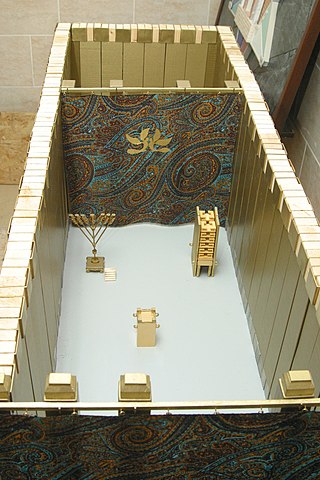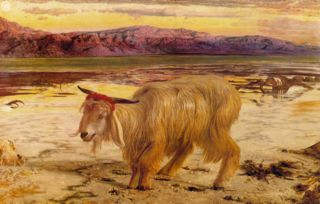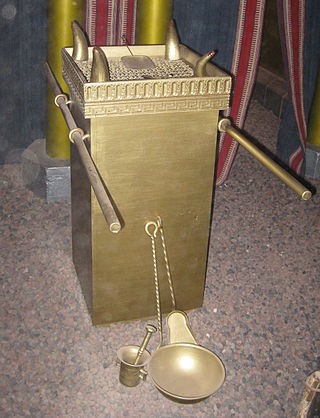Yohanan ben Zakkai, sometimes abbreviated as ריב״ז ribaz for Rabbi Yohanan ben Zakkai, was a tanna, an important Jewish sage during the late Second Temple period during the transformative post-destruction era. He was a primary contributor to the core text of Rabbinic Judaism, the Mishnah. His name is often preceded by the honorific title Rabban. He is widely regarded as one of the most important Jewish figures of his time, and his escape from the Roman destruction of Jerusalem may have been instrumental in Rabbinic Judaism's survival post-Temple. His tomb is located in Tiberias within the Maimonides burial compound.

The Jerusalem Talmud or Palestinian Talmud, also known as the Talmud of the Land of Israel, is a collection of rabbinic notes on the second-century Jewish oral tradition known as the Mishnah. Naming this version of the Talmud after Palestine or the Land of Israel—rather than Jerusalem—is considered more accurate, as the text originated mainly from Galilee in Byzantine Palaestina Secunda rather than from Jerusalem, where no Jews lived at the time.

The Holy of Holies is a term in the Hebrew Bible that refers to the inner sanctuary of the Tabernacle, where the Shekhinah appeared. According to Hebrew tradition, the area was defined by four pillars that held up the veil of the covering, under which the Ark of the Covenant was held above the floor. According to the Hebrew Bible, the Ark contained the Ten Commandments, which were given by God to Moses on Mount Sinai. The first Temple in Jerusalem, called Solomon's Temple, was said to have been built by King Solomon to keep the Ark.
In Judaism, the korban, also spelled qorban or corban, is any of a variety of sacrificial offerings described and commanded in the Torah. The plural form is korbanot, korbanoth, or korbanos.
Tetzaveh, Tetsaveh, T'tzaveh, or T'tzavveh is the 20th weekly Torah portion in the annual Jewish cycle of Torah reading and the eighth in the Book of Exodus. The parashah reports God's commands to bring olive oil for the lamp, make sacred garments for the priests, conduct an ordination ceremony, and make an incense altar.

Yoma is the fifth tractate of Seder Moed of the Mishnah and of the Talmud. It is concerned mainly with the laws or halacha of the Jewish holiday Yom Kippur, on which Jews atone for their sins from the previous year. It consists of eight chapters and has a Gemara ('Completion') from both the Jerusalem Talmud and the Babylonian Talmud.
Tamid is the ninth tractate in Kodashim, which is the fifth of the six orders of the Mishnah, Tosefta, and the Talmud.

Acharei Mot is the 29th weekly Torah portion in the annual cycle of Torah reading in Judaism. It is the sixth parashah or weekly portion (פָּרָשָׁה) in the Book of Leviticus, containing Leviticus 16:1–18:30. It is named after the fifth and sixth Hebrew words of the parashah, its first distinctive words.

Emor is the 31st weekly Torah portion in the annual Jewish cycle of Torah reading and the eighth in the Book of Leviticus. The parashah describes purity rules for priests, recounts the holy days, describes the preparations for the lights and bread in the sanctuary, and tells the story of a blasphemer and his punishment. The parashah constitutes Leviticus 21:1–24:23. It has the most verses of any of the weekly Torah portions in the Book of Leviticus, and is made up of 6,106 Hebrew letters, 1,614 Hebrew words, 124 verses and 215 lines in a Torah Scroll.

Berakhot is the first tractate of Seder Zeraim of the Mishnah and of the Talmud. The tractate discusses the rules of prayers, particularly the Shema and the Amidah, and blessings for various circumstances.

The Foundation Stone, or the Noble Rock is the rock at the center of the Dome of the Rock in Jerusalem. It is also known as the Pierced Stone, because it has a small hole on the southeastern corner that enters a cavern beneath the rock, known as the Well of Souls.
According to the Talmud, the House of Garmu was responsible for baking the Showbread offered in the Temple of Jerusalem. The Talmud praised the Garmu family for never permitting their children to be seen eating white bread, to avoid any possible suspicion that they might be appropriating Temple resources for their own personal use. The Talmud relates that they had a secret method of baking the Showbread in a way that preserved its freshness so that it remained fresh even after having been left on the Table for a week. They refused to disclose the secret and it became lost following the Second Temple's destruction in 70 CE.
The Hebrew term maaleh ashan is the traditional name of an herb which according to the Talmud was an ingredient of the ketoret, the incense offered in the Temple in Jerusalem. It was said to cause the smoke from the incense-offering to rise straight up.

Tractate Middot is the tenth tractate of Seder Kodashim of the Mishnah and of the Talmud. This tractate describes the dimensions and the arrangement of the Temple Mount in Jerusalem, and the Second Temple buildings and courtyards, various gates, the altar of sacrifice and its surroundings, and the places where the Priests and Levites kept watch in the Temple.

Shabbat is the first tractate of Seder Moed of the Mishnah and of the Talmud. The tractate deals with the laws and practices regarding observing the Jewish Sabbath. The tractate focuses primarily on the categories and types of activities prohibited on the Sabbath according to interpretations of many verses in the Torah, notably Exodus 20:9–10 and Deut. 5:13–14.

Since the 10th century BCE, Jerusalem has been the holiest city, focus and spiritual center of the Jews. Jerusalem has long been embedded into Jewish religious consciousness and Jews have always studied and personalized the struggle by King David to capture Jerusalem and his desire to build the Holy Temple there, as described in the Book of Samuel and the Book of Psalms. Many of King David's yearnings about Jerusalem have been adapted into popular prayers and songs. Jews believe that in the future the rebuilt Temple in Jerusalem will become the center of worship and instruction for all mankind and consequently Jerusalem will become the spiritual center of the world.

The incense offering in Judaism was related to perfumed offerings on the altar of incense in the time of the Tabernacle and the First and Second Temple period, and was an important component of priestly liturgy in the Temple in Jerusalem.

Leptadenia pyrotechnica is the botanical name of a desert herb of the family Apocynaceae. It is widespread from Senegal to India. It is known as khimp in Hindi and Urdu, and khipp in Punjabi.

Jewish law and custom prescribe ritual hand washing in a number of situations. This practice is generally known by the Hebrew term נטילת ידיים, which literally means taking up of the hands.
The incense offering, a blend of aromatic substances that exhale perfume during combustion, usually consisting of spices and gums burnt as an act of worship, occupied a prominent position in the sacrificial legislation of the ancient Hebrews.












